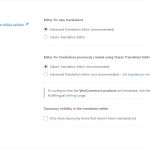This is the technical support forum for WPML - the multilingual WordPress plugin.
Everyone can read, but only WPML clients can post here. WPML team is replying on the forum 6 days per week, 22 hours per day.
This topic contains 25 replies, has 3 voices.
Last updated by T4ng 3 years, 11 months ago.
Assisted by: Sumit.
| Author | Posts |
|---|---|
| January 7, 2022 at 8:14 am #10303325 | |
|
Sumit Supporter
Languages: English (English ) Timezone: Asia/Kolkata (GMT+05:30) |
Hi, Yes, you are right I also changed WPML ATE setting after changing the URL from https to http, so this is not SSL issue. Anyway, I can see the problem. The AJAX is fine but this AJAX request also triggers an external REST request to our server, this request returns a communication error (you can see this in response of any of the requests). It is all related to Advanced Translation Editor. I tried many ways to reproduce this issue on my test site but I can not. On my test site if ATE is not active this request is not fired not sure why on your site it is in the loop even when ATE is not active. 1. Please go to WPML > Settings, then activate Advanced Translation Editor Thanks |
| January 7, 2022 at 8:34 am #10303409 | |
|
T4ng |
Hi Sumit |
| January 7, 2022 at 9:13 am #10303587 | |
|
T4ng |
I clicked classic in the first setting, then saved. |
| January 7, 2022 at 11:32 am #10304895 | |
|
Sumit Supporter
Languages: English (English ) Timezone: Asia/Kolkata (GMT+05:30) |
Hi, Thanks for the feedback. Now, you can keep whatever editor you like. We recommend Advanced Translation editor which offers more features than a classic editor but it is not a must. If you like to translate with a classic editor then keep using it. About the issue, I tried multiple ways but I can see the problem on our test sites. It seems the problem was due to temporary values in the database that are removed/changed once we change the Editor setting. Let me know if you have more questions. Thanks |
| January 10, 2022 at 3:03 pm #10319909 | |
|
T4ng |
Unfortunately, after: |
| January 11, 2022 at 1:09 pm #10327073 | |
|
Sumit Supporter
Languages: English (English ) Timezone: Asia/Kolkata (GMT+05:30) |
Hi, On my local server after fixing those continuous requests the CPU load is almost zero. The CPU is optimized only when there is a request, like a page load. And you also confirmed that the issue of the continuous request has been fixed. If this is the case then, please provide me production site details with the steps to see the issue? I am enabling the private reply. Instructions to send private information are here: hidden link Privacy and Security when Providing Debug Information for Support: Thanks |
| January 11, 2022 at 2:44 pm #10328127 | |
|
T4ng |
Yes, that's what I say. the server load seen via Plesk remains as high as it is for 2 months now, while I can't see the apps.js anymore (only 2 resquests when loading an admin page, but no more). |
| January 11, 2022 at 3:11 pm #10328553 | |
|
Sumit Supporter
Languages: English (English ) Timezone: Asia/Kolkata (GMT+05:30) |
Hi, Okay, I can not say about the server because I don't have access to the server to check. Because the server could be slow for many reasons but we can not debug that we can only check WPML issues. If I see the load time is increased by WPML more than expected then I will continue checking about the culprit. For that, please provide me staging or production site access to check. Because on our server it is pretty fast. Thanks |
| January 12, 2022 at 9:57 am #10333965 | |
|
T4ng |
Hi Sumit, Again, we're not really keen offering you access to our production environment. It's just random. This doesn't seem to happen on a specific admin page, it just doesn't happen everytime an admin page is loaded. |
| January 12, 2022 at 12:19 pm #10335387 | |
|
T4ng |
I juste realized that these app.js requests don't occur anymore, at all, as soon as W3TC page cache is disabled. |
| January 12, 2022 at 4:46 pm #10337965 | |
|
T4ng |
Well... After extensive testings, deactivating, reactivating methodically cache plugins and their options back and forth, we finally seem to get to lower the CPU/memory usage AND get rid of app.js requests. While it's satifsfying to get back to normal, we don't really understand what's going on. I suspect some settings were somehow held in cache... We'll definitly keep an eye on this. |

